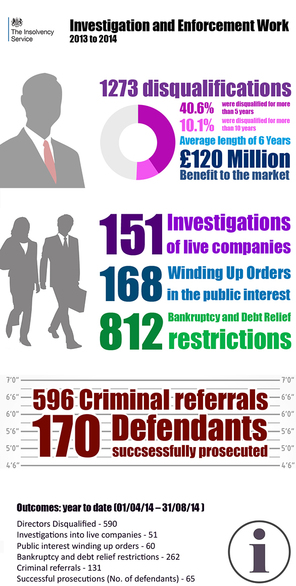
Britain’s insolvency regime is very well regarded and planned changes are designed to deliver further improvements. Legislation currently before Parliament will streamline insolvency law removing unnecessary costs and ensure effective oversight of insolvency practitioners. Provisions in the Small Business, Enterprise and Employment Bill will:
-
encourage greater use of electronic communication and remove administrative processes which add no value to creditors. These measures were developed with stakeholders as part of the government’s Red Tape Challenge and will save businesses creditors an estimated £20 million annually
- change the regulatory framework for insolvency practitioners to deal effectively and efficiently with poor performance and abuse, providing greater confidence in the insolvency profession
- strengthen the company director disqualification process with greater intelligence sharing, enable the court to take greater account of previous company failures and introduce a new compensation order to help creditors
-
create a reserve power to prohibit ‘pre-pack’ administration sales to connected parties should the package of improvements recommended in the recently published Teresa Graham report not be successfully implemented.
The Bill will be considered in committee by the House of Commons in October. If enacted, the provisions of the bill would come into effect in 2015 and 2016.
There are also deregulatory measures in the Deregulation Bill currently before Parliament, including measures to facilitate provision of bank accounts to undischarged bankrupts and to allow specialised authorisation of insolvency practitioners.
Back to Top
|
Regulation of the insolvency profession has been debated in recent years and we committed last year to strengthening our role as oversight regulator to encourage best practice and ensure that any poor performance or misconduct is dealt with consistently. Working with the seven recognised professional bodies that directly authorise and monitor insolvency practitioners we are introducing a package of improvements:
-
we have established a common gateway for complaints about insolvency practitioners
-
our insolvency practitioner regulation function has been strengthened and we have raised the bar on our expectations of authorising bodies
- we will in future publish on our website in a standard format details of sanctions handed down by recognised professional bodies to the insolvency practitioners they regulate
-
we will publish the reports of our regular monitoring of authorising bodies. We chose to lead by example and have published the first report into our own direct regulation function. It didn’t always make for comfortable reading. We saw the impact that our changing expectations had in a few areas. Things deemed acceptable a few years ago were now being picked up as areas for improvement. What was encouraging was that many of the concerns we raised as oversight regulator had already been identified, with steps already in hand to amend and update processes. The recommendations for improvement have all been accepted, and our monitoring team will be working with Insolvency Practitioner Services to ensure that changes are effectively implemented. Reports into the other recognised professional bodies will follow.
Back to Top

Confidence that businesses are playing by the rules is fundamental to a well functioning market. Our investigators look at director and corporate behaviour of both insolvent businesses and live companies and we pursue those who have abused the system, removing them from the marketplace. We publicise many of the director disqualifications we achieve to provide a deterrent to others and give confidence that the rules of the market are being enforced. This work has real world consequences:
- land scams operated by 111 companies we wound up cost more than 1,700 investors over £96m; to date, 45 directors of those companies have since been disqualified for a total of 439 years
-
we disqualified seven former directors of a solicitors practice who had been trading fraudulently and failed to keep proper books and records. More than £13 million was paid out to former clients of the practice from the Solicitors Compensation Fund
Collaboration with insolvency practitioners is critical to us in securing disqualifications for directors who have committed wrong doing. Last year over 1,200 individual directors were disqualified and we expect to achieve a similar number of disqualifications this year – 590 directors were removed from the marketplace by the end of August. This not only levels the playing field for competitor companies who are playing by the rules, it also prevents further damage to the economy with an estimated £100,000 net benefit for every director who is disqualified.
Vicky Bagnall
Director of Investigation and Enforcement Services
Back to Top
|
Our project to streamline statutory redundancy and insolvency payments takes another step forward this month when live testing of the new online service begins with a select number of users. Last year 75,000 individuals made a claim for statutory redundancy pay and insolvency payments because their insolvent employer was unable to pay out themselves. Currently the process is paper based, with claimants required to complete at least an initial 16-page form. The Redundancy Payments Service is moving this process online as one of the government’s 25 ‘exemplar’ projects which aim to make public services simpler, clearer and faster to use. To ensure the digital service is easy to use, the project team has worked with users, claimants and insolvency practitioners, at every stage. Arrangements for those who can’t use or access the online service are being put in place. Testing will continue until December with feedback used to further improve the process. In 2015, a larger scale public trial of the project will be run ahead of the system going fully live when use of paper forms will cease.
Back to Top
29 October: Insolvency Statistics, July to September 2014 published
12 November: Individual voluntary arrangement outcome statistics, England and Wales, 1990-2013 published
3 December: Individual Insolvencies by parliamentary constituency, England and Wales, 2013 published
Back to Top
If you have any feedback on this newsletter or other issues please email us.
Back to Top
|